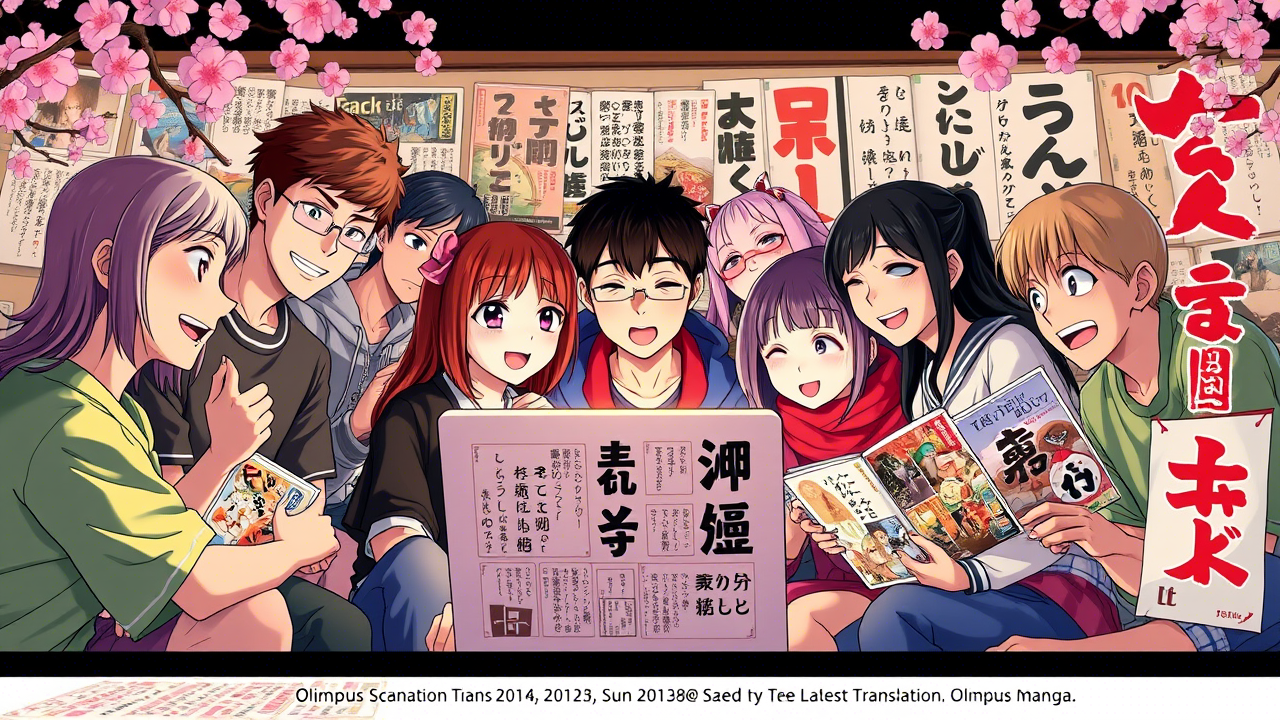Manga, the Japanese style of comics and graphic novels, has become a global phenomenon. With millions of fans worldwide, the demand for accessing the latest manga titles is higher than ever. However, due to language barriers and limited official translations, a group of dedicated fans began translating manga on their own, creating a movement known as scanlation. One of the most notable groups in this movement is Olympus Scanlation. In this article, we’ll explore the ins and outs of Olympus Scanlation, from its inception to its role in the global manga community.
Introduction to Olympus Scanlation
What is Scanlation?
Scanlation refers to the process of scanning, translating, and editing manga from its original language (usually Japanese) into another language. This process is typically carried out by fan groups who are passionate about the stories and want to share them with a broader audience. Scanlation enables fans to access manga titles that might not be officially available in their language. The process can vary, but it usually includes scanning raw manga pages, translating the text, and then typesetting the translated text onto the images.
The History of Scanlation

Scanlation has a rich history, dating back to the early 1990s when the internet first made it possible for people to share digital files across the globe. Fansubbing, a similar practice for anime, was the precursor to scanlation. The first scanlation groups were small, underground communities that worked on translating and distributing manga to English-speaking fans. Over the years, these groups grew in size and influence, with more skilled translators, editors, and typesetters joining the effort.
Olympus Scanlation became one of the prominent groups in this movement, producing high-quality translations of popular manga titles. Their focus on providing detailed and faithful translations helped them garner a strong following. The group was formed in response to the increasing demand for non-Japanese manga fans to access works that were unavailable in their regions. As the internet grew, Olympus Scanlation also expanded, reaching global audiences.
Understanding Olympus Scanlation
Olympus Scanlation stands out among scanlation groups due to its commitment to quality and speed. The group has worked on a wide range of manga titles, from mainstream hits to niche series, covering a variety of genres. Their translators are known for their attention to detail, ensuring that cultural nuances and idiomatic expressions are preserved while still making the text accessible to a global audience. The group’s reputation for professionalism in the world of fan translations has made it one of the most respected scanlation teams within the manga community.
The Process of Scanlation in Olympus
Step-by-Step Overview of Scanlation
The scanlation process is a collaborative effort that involves several key steps, each of which requires specific expertise. The first stage is scanning the original manga pages. These raw scans are usually obtained from physical copies of the manga or Japanese web releases. Once scanned, the images are cleaned up by removing imperfections like dust, smudges, or text from the original Japanese version.
Next comes the translation phase. Skilled translators convert the original Japanese text into the target language, making sure to retain the meaning and context of the dialogue. Translators also work to preserve cultural references and wordplay, making adjustments where necessary to make the text flow naturally in the new language.
Finally, typesetting is performed, where the translated text is inserted back into the manga pages. Typesetters have to ensure that the text fits properly within the speech bubbles and maintains the visual appeal of the manga. This step requires a good eye for design and knowledge of the manga’s original layout.
The Roles of Team Members
Olympus Scanlation is made up of various members who each play an essential role in creating high-quality translations. Translators are responsible for converting the original Japanese dialogue into the target language, ensuring it makes sense both culturally and linguistically. Editors refine the translation, making adjustments to grammar, style, and readability.
Typesetters are responsible for inserting the translated text into the artwork, ensuring that the visual integrity of the manga is maintained. They also adjust the font size, style, and placement to fit the speech bubbles seamlessly. Cleaners focus on making the pages look as close to the original as possible by erasing any Japanese text or markings that might be left on the pages. Each team member contributes a critical piece to the puzzle, ensuring the final product is polished and accurate.
Tools and Software Used by Olympus
Olympus Scanlation utilizes various tools to streamline their work. For scanning, they use high-quality scanners or digital cameras to capture each page. Photoshop is commonly used for cleaning up the images and editing the text. OCR (Optical Character Recognition) tools may also be employed to extract text from the scans, but manual intervention is often needed to ensure accuracy. For typesetting, teams rely on programs like Adobe Illustrator or InDesign, which offer robust tools for working with text and images. Additionally, team members often use cloud-based project management tools like Trello or Slack to stay organized and collaborate remotely.
Legal and Ethical Implications of Scanlation
Legal Concerns with Scanlation
Scanlation, while beloved by many fans, exists in a legal gray area. The process of scanning and translating copyrighted manga without permission from the original creators or publishers can be seen as an infringement on intellectual property rights. Official publishers often hold the rights to the manga in various regions, and distributing fan-translated works can conflict with their ability to monetize the material. While scanlation is technically illegal in many regions, its enforcement is often inconsistent, particularly when the translated work is not commercially available in certain languages.
Olympus Scanlation, like many fan groups, faces potential legal risks due to the distribution of unauthorized translations. Some manga publishers have sent cease-and-desist letters to scanlation groups, demanding that they take down their translations. However, many scanlation groups argue that they’re providing a service by giving fans access to works that would otherwise be unavailable in certain regions.
Ethical Considerations
The ethical debate around scanlation is multifaceted. On one hand, scanlation allows fans to experience manga that may not be officially localized or may take years to be translated. Many argue that it helps cultivate global interest in manga and promotes Japanese culture. However, there’s also the concern that scanlation can undermine official sales and hurt the bottom line of publishers and creators.
Olympus Scanlation tries to balance these issues by being transparent about their activities and respecting the wishes of manga creators. In some cases, they will stop translating a series once it has been officially licensed for an English release. Their ethics center around promoting the love of manga while not actively competing with or harming the official industry.
Olympus Scanlation’s Approach to Ethics
Olympus Scanlation strives to be a responsible member of the scanlation community. They’re committed to producing high-quality translations and to respecting the legal rights of creators whenever possible. This means that when an official publisher licenses a series, Olympus Scanlation will generally stop producing translations for that series. This commitment to ethical behavior helps them maintain a good relationship with both fans and creators.
The Impact of Olympus Scanlation on the Manga Community
Cultural and Community Impact
Olympus Scanlation has had a profound impact on the global manga community. By providing high-quality translations of Japanese manga, they’ve helped to bridge the gap between Japan and international fans. In many cases, their translations have been the first opportunity for fans outside of Japan to read specific series, allowing them to experience the stories and characters in real-time. This has led to an increase in the popularity of manga worldwide, as fans can now access a vast library of content that would have otherwise been inaccessible.
Furthermore, Olympus Scanlation has contributed to the growth of a global manga community. Fans often gather online to discuss translated manga, share fan art, and exchange thoughts on the latest releases. By providing these translations, Olympus has played a key role in fostering a vibrant, interconnected community of manga enthusiasts.
Reception by Fans
Olympus Scanlation enjoys a loyal following among manga fans. Their translations are known for their accuracy and attention to detail, which is why many readers prefer them over other fan groups. Fans appreciate Olympus’s effort to maintain the tone and nuances of the original Japanese text while making it accessible and enjoyable in their own language. This dedication has earned them a reputation for professionalism within the scanlation world.
Challenges and Criticisms
While Olympus Scanlation is highly regarded, they are not without their challenges. One major issue is the speed at which they can produce translations, especially for long-running series. Fans often expect quick releases, but the process of translating and typesetting is time-consuming and meticulous. Additionally, Olympus, like other scanlation groups, faces criticism from those who believe that fan translations compete with official publishers and undermine the industry.
Conclusion
Olympus Scanlation has carved a niche for itself in the world of manga fan translations. Through their dedication to quality, cultural preservation, and ethical responsibility, they’ve become one of the most influential groups in the scanlation community. While their work exists in a legal gray area, the impact they’ve had on the global manga scene is undeniable. Whether you agree with scanlation or not, there’s no denying the passion and effort that goes into bringing manga to readers around the world.
FAQs
What is the difference between scanlation and official manga translations?
Scanlation is a fan-driven process where volunteers translate and edit manga without official permission. Official translations are done by licensed publishers who have agreements with the original creators.
How does Olympus Scanlation choose which manga to translate?
Olympus typically selects manga based on demand and availability. They focus on titles that are either not licensed in certain regions or haven’t been officially translated yet.
Is scanlation illegal?
Technically, scanlation is illegal as it involves distributing copyrighted material without permission. However, enforcement varies, and many scanlation groups operate in a legal gray area.
How can I support Olympus Scanlation if I’m a fan?
You can support Olympus by spreading the word about their translations, donating to the group (if they accept donations), or purchasing official versions of the manga they translate to support the creators.
Can Olympus Scanlation collaborate with official publishers?
In some cases, scanlation groups like Olympus collaborate with publishers by halting translations once the official English release is available. However, direct partnerships are rare.
You May Also Read: https://zibbusiness.com/statekaidz-com/





